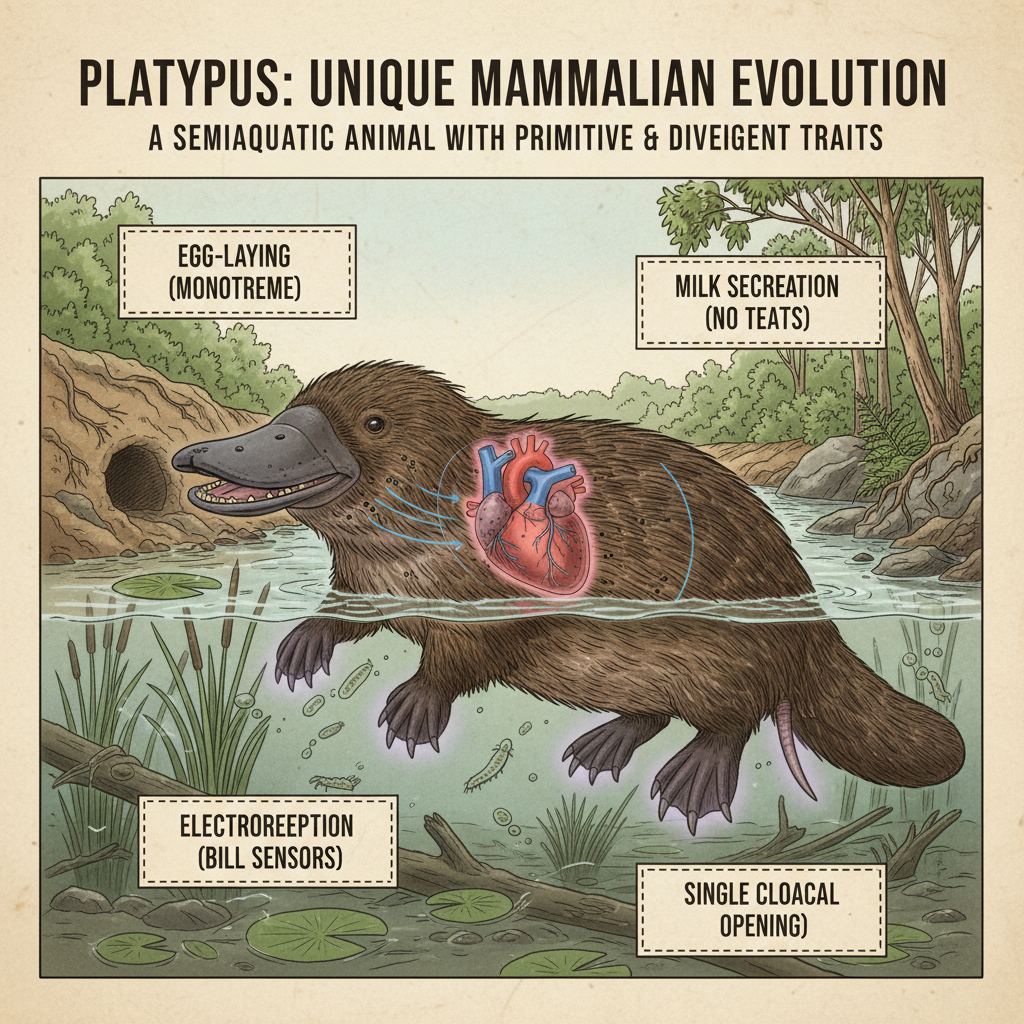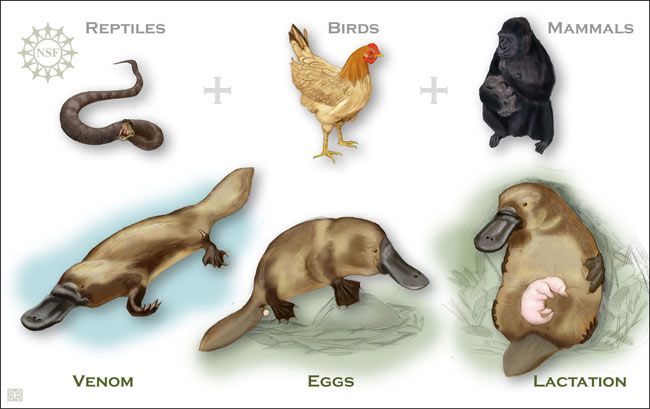
Platypus Biology: Unique Egg-Laying Mammal with Electroreception and Venom
The platypus (Ornithorhynchus anatinus) is a unique mammal from Australia and New Guinea, notable for blending reptilian, avian, and mammalian traits. As one of only five monotreme species, it reproduces by laying leathery eggs and feeds its young with milk secreted through skin pores instead of nipples. Adapted to a semiaquatic lifestyle, the platypus has dense waterproof fur, a four-chambered heart, and a bill equipped with electroreceptors to detect prey underwater. It also features venomous spurs in males and a single cloacal opening, traits that underline its ancient evolutionary lineage. Often called a ‘living fossil,’ the platypus provides key insights into mammalian evolution and exemplifies nature’s remarkable adaptability.
Summary
The Platypus: A Unique Blend of Evolutionary Traits
The platypus (Ornithorhynchus anatinus) stands out as one of nature’s most remarkable mammals, combining distinctive characteristics that challenge conventional mammalian biology. Belonging to the monotreme group—the only mammals capable of laying eggs—the platypus exemplifies a mosaic of reptilian, avian, and mammalian features. Native to Australia and New Guinea, monotremes include just five extant species: the platypus and four species of echidnas, all of which provide valuable insight into early mammalian evolution.
Reproductive Biology and Egg-Laying
Unlike the majority of mammals, the platypus reproduces through the laying of leathery eggs, a primitive trait shared exclusively with echidnas among living mammals. This reproductive strategy reflects an ancient lineage dating back over 160 million years. Instead of typical mammalian nipples, the platypus feeds its young by secreting milk through specialized pores in the skin. The offspring then lap up the milk directly, an adaptation unique within mammalian reproductive biology.
Physiological Adaptations
As an endothermic animal, the platypus maintains a warm body temperature of approximately 32°C, which is notably lower than that of most placental mammals. Its fur is dense and layered, providing effective waterproof insulation essential for its semiaquatic lifestyle. The presence of a four-chambered heart further aligns the platypus physiologically with more derived mammals.
One of the most extraordinary features is the bill, equipped with electroreceptors capable of sensing electrical signals emitted by prey underwater. This electroreception system is unparalleled among mammals and allows the platypus to detect insect larvae, small crustaceans, and other aquatic prey even in murky conditions. This remarkable sensory adaptation puts the platypus alongside sharks in terms of electroreception capabilities.
Additional Unique Characteristics
Adult platypuses lack teeth, instead possessing grinding plates for processing food. Their early development includes temporary teeth which are soon shed. Males exhibit a rare trait among mammals: venomous spurs on their hind legs. These spurs deliver venom primarily used during male-to-male competition in the breeding season.
Another primitive feature is the single cloacal opening, shared with reptiles and birds, used for excretion and reproduction. This anatomical trait contrasts sharply with the separate openings typical of most other mammals.
Evolutionary Significance
The platypus is often described as a ‘living fossil’ due to its retention of multiple ancestral traits alongside mammalian characteristics. This unique combination underscores the complex evolutionary history that diverged from other mammals more than 160 million years ago. The presence of electroreception, egg-laying, venomous spurs, and milk secretion without teats highlights the platypus as a vital subject for studying evolutionary transitions and the diversity of life.
Conclusion
The platypus defies standard mammalian conventions through its egg-laying reproduction, electroreceptive hunting, venom production, and distinctive lactation method. Its extraordinary biology not only bridges features from mammals, birds, and reptiles but also enriches our understanding of evolutionary adaptation. Studying Ornithorhynchus anatinus provides a window into the deep evolutionary past and the remarkable pathways of natural history in Australia and New Guinea.

Frequently Asked Questions
Q: Why does the platypus not have teats?
A: The platypus does not have teats because it is a monotreme, a type of egg-laying mammal. Instead of nipples, female platypuses secrete milk through specialized mammary gland ducts that ooze milk onto the surface of their skin or into grooves, allowing the young to lap it up. This primitive method differs from placental mammals, which have well-developed teats or nipples for nursing. This adaptation suits the platypus's evolutionary lineage and reproductive strategy.
Q: Which mammals lay eggs?
A: Only a small group of mammals known as monotremes lay eggs. This group includes the platypus and echidnas (also called spiny anteaters). Unlike most mammals that give birth to live young, monotremes lay leathery eggs and incubate them until they hatch. Despite laying eggs, monotremes are still warm-blooded and nurse their young with milk.
Q: How does the platypus feed its young?
A: The platypus feeds its young by producing milk from mammary glands, but it does not have nipples. Instead, milk is secreted through openings in the skin, and the young lap it up from the mother's fur. The mother curls her body around her babies in the burrow, allowing them to nurse until they are mature enough to feed themselves.
Q: What makes the platypus unique among mammals?
A: The platypus is unique among mammals because it lays eggs instead of giving birth to live young, a trait rare in mammals. It also has a distinctive duck-like bill that is highly sensitive and helps detect prey underwater. Additionally, the platypus is one of the few venomous mammals, with males possessing spurs on their hind legs that can deliver venom. Its combination of reptilian and mammalian features makes it an extraordinary example of evolutionary adaptation.
Q: Can platypus venom harm humans?
A: Yes, platypus venom can harm humans. Male platypuses have spurs on their hind legs that deliver venom capable of causing severe pain, swelling, and tissue damage. While the venom is not typically lethal to humans, the effects can be extremely painful and may require medical attention. The venom is primarily used by males during the breeding season to assert dominance over rivals.
Key Entities
platypus: The platypus is a semi-aquatic mammal native to eastern Australia and Tasmania, known for its duck-like bill and unique reproductive method of laying eggs. It is one of the few monotremes, a group of egg-laying mammals that also includes echidnas.
Andreas Zedrosser: Andreas Zedrosser is a researcher who has contributed to studies on the evolutionary biology of monotremes such as the platypus. His work helps illuminate the genetic and ecological aspects of species native to Australia and New Guinea.
echidnas: Echidnas are egg-laying mammals, or monotremes, found in Australia and New Guinea characterized by their spiny coats and long, sticky tongues for catching insects. Together with the platypus, they represent one of the most primitive branches of mammals.
Australia: Australia is a continent and country known for its unique wildlife, including monotremes like the platypus and echidnas. It provides diverse habitats ranging from rainforests to arid deserts, supporting a wide array of endemic species.
New Guinea: New Guinea is an island located to the north of Australia, home to diverse ecosystems including rainforests where echidnas are found. It is the world’s second-largest island and shares some unique animal species with Australia due to their geological history.
External articles
Articles in same category
- Beaver Lodges and Ecosystem Engineering: Wildlife Interactions and Conservation Insights
- NASA Pushes Artemis II Lunar Mission Amid Government Shutdown and Leadership Controversy
- Orionid Meteor Shower 2025: Peak Viewing of Halley’s Comet Debris in October
YouTube Video
Title: The Evolution of the Platypus 🦆⏳ | Nature’s Strangest Mammal
URL: https://www.youtube.com/shorts/S7oe52DiVqA
Science